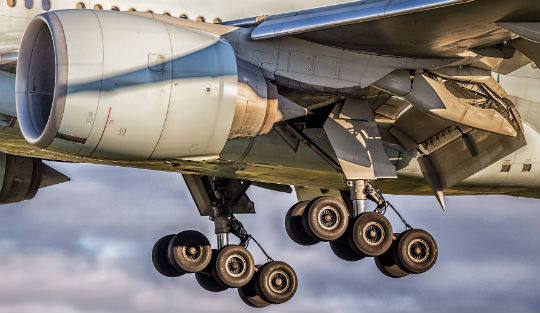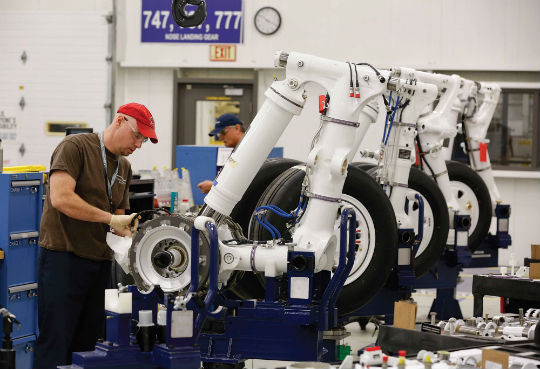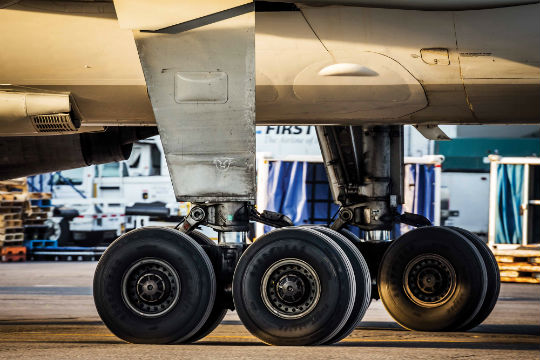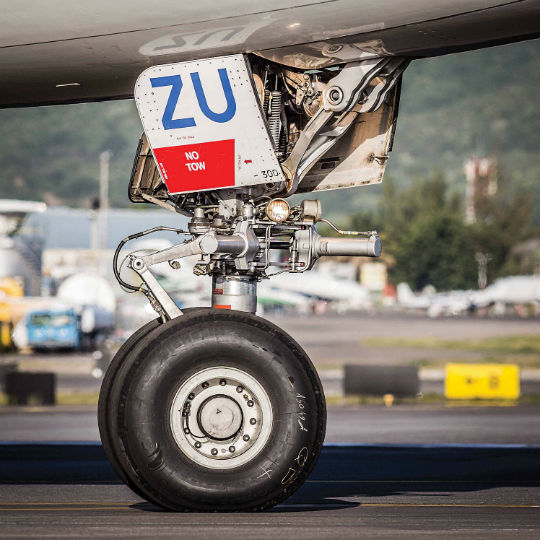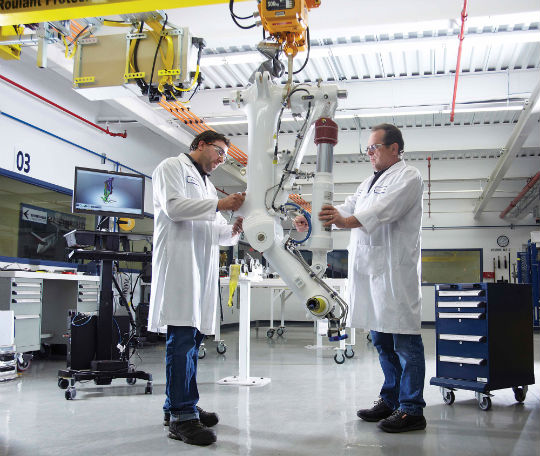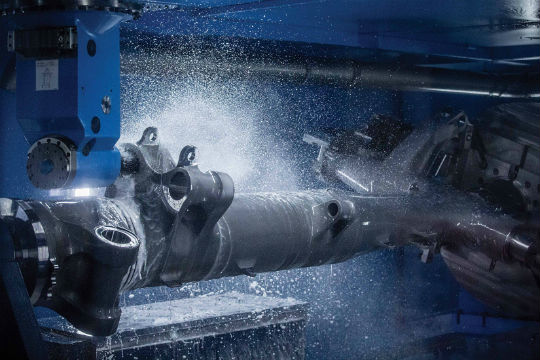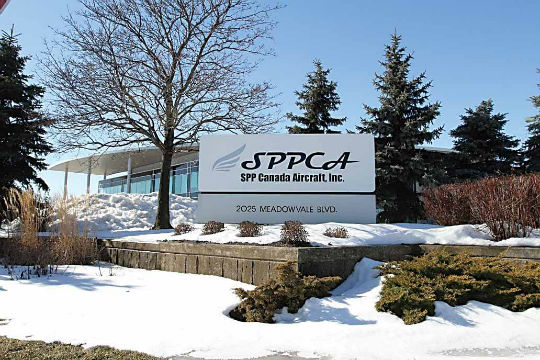Up close and personal with an Air Canada Boeing 777’s triple-bogey landing gear. In 1992, UTAS Landing Systems (then Menasco) won the Boeing contract to build landing gear for the 777 in Oakville. In 2013, Boeing awarded a new contract for 777 and 777X landing gear to Héroux-Devtek Inc., which subsequently opened a 108,000-square-foot manufacturing plant in Cambridge, Ont., to help it fulfill the agreement. Deliveries under the new contract are scheduled to begin in early 2017. Jan Jasinski Photo
Every day, tens of thousands of aircraft equipped with Canadian-built landing gear take off and land at airports around the world.
The range of Canadian landing gear systems is as diverse as aircraft in the sky. In fact, an estimated 45 to 50 per cent of all business and commercial aircraft in production today (20,000 pounds and heavier) are equipped with Canadian-made landing gear systems.
The list includes every Boeing 737, as well as the Bombardier Challenger, Global, CRJ and Dash 8/Q400; the wide-body Boeing 747, 777 and 787; the double decker Airbus A380; and even the Apollo Lunar Module that landed mankind on the moon.
Market demand
The market for landing gear is directly tied to global demand for new aircraft.
Boeing forecasts a need for 38,050 commercial aircraft valued at close to $5.6 trillion over the next 20 years, with 39 per cent of the demand coming from the Asia-Pacific region. This includes a requirement for 26,730 regional and single-aisle jets and 8,830 wide-body aircraft. In addition, Bombardier Business Aircraft is forecasting deliveries of 9,000 new business jets over the next decade.
The growing airline demand has already pushed production for the Boeing 737 and Airbus A320 (and accompanying landing gear) to a record 42 aircraft a month (and soon to 50 a month), and the Boeing 787 to 10 aircraft a month–the highest rate ever for a wide-body aircraft.
Then and now
The Canadian landing gear industry was established to support wartime production of trainers, fighters and bombers beginning in 1939. These included the Anson, Hurricane, Hampden, Bolingbroke, and Lancaster.
Post-war, Canadian aircraft manufacturers produced thousands of new and licensed-built civil and military aircraft with landing gear made in Canada.
Then, starting in the mid-1960s, Canadian landing gear makers started to export their products to airframe original equipment manufacturers (OEMs) in other countries.
Inspecting the diameter of holes machined on a landing gear outer cylinder at Messier-Bugatti-Dowty’s (MBD’s) facility in Mirabel, Que. Christian Fleury/MBD Photo
Today, four Tier 1 landing gear system integrators–Messier-Bugatti-Dowty (MBD); UTC Aerospace Systems – Landing Systems (UTAS); Héroux-Devtek; and SPP Canada Aircraft, Inc. (SPPCA)–operate busy Canadian facilities.
These companies deliver integrated landing gear systems to OEMs such as Airbus, Boeing, Bombardier, Dassault, Embraer, Gulfstream, Honda, Lockheed Martin, Northrop Grumman, Sikorsky and Viking Air.
From a business perspective, Canadian landing gear production generates about six per cent of Canada’s $28 billion in aerospace sales. From a systems perspective, the scope of the landing gear industry includes landing gear legs, the hydro-mechanical extension and retraction systems, steering and braking systems, cockpit controls, monitoring systems, doors and wheels, brakes and tires.
Competition
“All the big airframe OEMs are looking to outsource the design and production of landing gear systems,” observed Gilles Labbé, president and CEO of Héroux-Devtek of Quebec, now the world’s third-largest landing gear manufacturer. “To win their business, you have to provide good service, high quality and on-time delivery, and at the same time help them reduce costs.”
Over the past 20 years, airframe OEMs have reduced their in-house manufacturing to focus on integrated systems assembly, and their supplier lists are shrinking, reported Deloitte LLP. As well, “OEMs are putting more pressure on their suppliers to provide integrated solutions to feed their final assembly line…suppliers are required to invest in research and development and share more financial risk in product innovation to support OEMs.”
The number of Tier 1 landing gear suppliers has shrunk to about 10 companies as a result of recent merger and acquisition activity, observed Masayuki (Mike) Onishi, vice president and chief operating officer of SPPCA.
In 2011, SAFRAN merged Messier-Dowty and Messier-Bugatti to create Messier-Bugatti-Dowty; then, in 2012, UTC Aerospace Systems was formed after United Technologies Corp. bought Goodrich and merged it with Hamilton Standard.
Work scope
“Landing gear manufacturers start working with airframe OEMs when a new aircraft is just a preliminary design concept,” explained Tim Whittier, director of government relations for UTC Aerospace Systems – Landing Systems.
UTAS employs about 1,000 Canadians at its 395,000-square-foot landing gear factory established in Oakville in 1984, and an MRO facility located nearby in Burlington, Ont. UTAS Photo
That’s because the size, weight, configuration and space requirements of the landing gear system are important engineering inputs that influence an aircraft’s weight, performance and structural design.
“Every airframe manufacturer has a slightly different philosophy regarding the landing gear system, and this extends to the work scope of a contract and the level of systems integration a Tier 1 supplier will provide,” added Whittier.
Historically, Boeing has played a very active role designing and integrating its landing gear systems, but this changed when it outsourced the design and integration to MBD for the Boeing 787 Dreamliner.
Bombardier Aerospace took a similar approach more than a decade earlier in 1993, when it outsourced the complete design, development, procurement and integration of the landing gear for the BD-700 Global Express business jet and all subsequent aircraft.
MBD won Bombardier’s Global Express and Challenger 300 business, while UTAS (as Menasco and Coltec Aerospace Canada) won the Bombardier Q400 turboprop and CRJ700/900/1000 regional jet contracts, respectively.
Both Canadian landing gear factories became more competitive as a result of these Bombardier contracts, which fundamentally expanded their capabilities.
Developing a fully integrated landing gear requires the Tier 1 system integrator to design, make or buy the landing gear components, the extension/retraction and steering actuation, the position and warning system, the integration of wheels, brakes and tires, and the associated sensors and controls, including cockpit controls.
SPPCA’s Onishi said most landing gear manufacturers adhere to a strict “make or buy'” strategy.
The landing gear industry includes landing gear legs, the hydromechanical extension and retraction systems, steering and braking systems, cockpit controls, monitoring systems, doors and wheels, brakes and tires. Jan Jasinski Photo
“A careful analysis is made to determine which parts you build in-house and which you outsource to optimize productivity, efficiencies and profitability,” explained Onishi, noting that most Tier 1 companies make about 20 per cent of the landing gear parts in house and subcontract 80 per cent to lower cost Tier 2 and Tier 3 suppliers.
The outsourcing strategy has helped nurture numerous small- and medium-sized landing gear component manufacturers and specialty processing shops in Canada, making it an attractive location for other landing gear companies to invest.
In fact, the governments of Canada, Ontario and Quebec have been strong supporters of Canada’s landing gear sector, providing tens of millions of dollars in loans and grants to support research and development, plant upgrades and factory expansions.
New challengers
Today, MBD and UTAS together have about 80 per cent of the global commercial landing gear business (by revenue).
Smaller Tier 1 landing gear systems integrators like Héroux-Devtek of Canada, Sumitomo Precision Products Co., Ltd. (SPP) of Japan [the sole shareholder of SPPCA], and Liebherr-Aerospace of Germany are now competing and winning landing gear contracts from larger airframe OEMs.
For example, Leibherr-Aerospace won the landing gear contract for the new Bombardier C Series; SPP won the contract for the Mitsubishi MRJ90 regional jet; and, in 2013, Boeing awarded Héroux-Devtek a large contract to supply the landing gear for the 777 and new generation 777X. This was a watershed contract, since Boeing looked beyond UTAS to make landing gear for its new wide-body jet.
One unusual characteristic of the landing gear industry is that Tier 1 equipment makers compete against each other for some contracts and team with each other to win other deals.
“The business is a little like mixed farming,” commented one industry observer. “You need to do a lot of different things to sustain your business.”
Getting part of the landing gear business for a new aircraft platform is better than being frozen out of a supply chain and thereby losing sales and opportunities for decades.
Hardware
In Canada, the landing gear industry is more than the sum of all its parts.
Step inside one of the country’s Tier 1 landing gear factories or Tier 2 suppliers, and you will see alloy forgings in the general shape of a landing gear being machined into high quality aircraft components, using state of the art computer numerical control (CNC) machine tools.
Landing gear is designed to last the lifetime of an aircraft and operate flawlessly every time. All components are designed to endure the most demanding structural loads, which for a wide-body aircraft is a high-speed turn off an active runway, not a landing or takeoff.
A typical Boeing 737 landing gear leg is approximately 10 feet tall, with a cross-section of nine to 10 inches, and can weigh upwards of 1,200 pounds.
The number of Tier 1 landing gear suppliers has shrunk to about 10 companies as a result of recent merger and acquisition activity. Jan Jasinski Photo
The most common metals used to manufacture landing gear are 300M steel, titanium Ti-10-2-3, titanium 5553 (only used on the 787 and Airbus A350-1000), and “Hy-Tuf” alloy steel (developed for military aircraft), with aluminum only used for very light aircraft. The largest landing gear systems are using more titanium parts to save weight and reduce aircraft fuel burn.
Large wide-body passenger jets like the Airbus A350, A380 and Boeing 777 require large four- or six-wheel bogie-type gears to keep the pavement loading of the wheels within prescribed limits.
In recent years, lighter materials such as titanium and carbon composites have been introduced to reduce aircraft weight and fuel consumption, along with new green anti-corrosion treatments that are kinder to the environment, and greater use of electro-mechanical or electric hydrostatic accessories.
A good example is electric actuated carbon brakes on the Boeing 787, which provide a major step forward in braking safety, efficiency and comfort, along with lower costs.
Messier-Bugatti-Dowty (MBD)
A subsidiary of Safran Group, MBD is a world leader in landing gear systems.
“A major differentiator between Messier-Bugatti-Dowty and other landing gear manufacturers is that everything we build is designed by our engineers, which allows us to integrate our advanced technologies,” said Stewart Odurny, director of North America commercial and marketing for MBD in Ajax, Ont.
Dowty Equipment (Canada) Ltd. opened its first office in Canada in October 1939 and moved from Montreal to Ajax, near Toronto, in 1949, following landing gear orders from Avro Canada.
Walking through the 204,000-square-foot Ajax factory today, visitors can see rough steel being machined into precision crafted landing gear, and “fully dressed” landing gear outfitted with hydraulic lines, brakes, wheels and tires for the Boeing 787, Bombardier Challenger 350, Challenger 605 and Global 5000/6000, as well as the Bell-Boeing V-22 tilt-rotor and the Boeing A/F-18E/F Super Hornet and Growler nose gear.
“We specialize in manufacturing medium-size, complex landing gear parts and integrating landing gear systems at our Ajax factory, and machine outer cylinders for Airbus and Boeing landing gear at our Mirabel factory,” explained Odurny.
Built at a cost of $90 million in 1991 and further expanded in 2013, the Mirabel plant makes main fittings or outer cylinders, a major structural part of landing gear, for the Airbus A320, A330, A380 NLG and A350, and the Boeing 787.
In 2005, Boeing awarded MBD a contract to design and provide an integrated landing gear system for the new generation 787 Dreamliner.
MBD is responsible for the design, development, testing and manufacture of the main and nose landing gear structure. The 787 was MBD’s first prime contract with Boeing for a commercial aircraft and the first time the OEM outsourced the design of a twin aisle aircraft landing gear.
Every couple of days, trucks depart the Messier-Bugatti-Dowty factory east of Toronto, carrying nose and main landing gear destined for 787 production lines in the United States.
“Fully dressed” nose gear goes to Spirit Aerospace in Wichita, Kan., for installation in the forward fuselage of the 787, and the main gears are delivered to the Boeing 787 assembly lines in Everett, Wash., and Charleston, S.C.
Production of 787 landing gear parts is spread amongst MBD facilities in Canada, China, France, Mexico and the U.K.
The engineers at MBD in Canada are currently designing and building the integrated landing gear system for the high capacity Boeing 787-10 and the new generation Bombardier Global 7000/8000 business jets.
UTC Aerospace Systems – Landing Systems (UTAS)
“The core competency of our Oakville plant is the design, test and manufacturing of large commercial landing gear,” explained Tim Whittier of UTAS. “This is UTAS’s largest landing gear manufacturing facility and it produces landing gear for Airbus, Boeing, Bombardier and Gulfstream.”
UTAS employs about 1,000 Canadians at its 395,000 square foot landing gear factory established in Oakville in 1984, and an MRO facility located nearby in Burlington, Ont.
Today, the Oakville plant makes landing gear for the Boeing 737, 747, 767 and 777, Bombardier Q400 and CRJ700/900/1000, Gulfstream G450/550, G650 and the 20-wheel main landing gear system for the Airbus A380.
The company has been making landing gear parts since the early 1950s, when Jarry Hydraulics became a Canadair subcontractor. Abex bought the company in 1962, Menasco in 1971, Colt Industries in 1980, Goodrich in 1999, and finally United Technologies Corp. in 2012.
A subsidiary of Safran Group, Messier-Bugatti-Dowty (MBD) engineers design all components of the company’s landing gear systems. Christian Fleury/MBD Photo
Jarry’s first original design was the nose gear for the Avro Arrow, followed by landing gear for other Canadian, American and European aircraft, including the de Havilland DHC-4 Caribou, DHC-5 Buffalo and Dash 7, Canadair CL-41 and CL-84, Shorts 3-30, Fairchild Republic A-10 and Fokker F100 (main gear).
In July 1965, Jarry Hydraulics of Montreal won an initial $500,000 order from Boeing for 25 sets of landing gear for the new Boeing 737 in July 1965.
Since 1967, more than 8,600 Boeing 737s have rolled off the Renton production line on Canadian-built landing gear with aircraft (and landing gear) production now at 42 units a month, and scheduled to reach 50 to 52 units a month by 2017, with one landing gear currently assembled every 4.5 hours.
In 1991, Menasco Aerospace Canada won a major Boeing contract to design and build the nose and main landing gear for the Boeing 777, the world’s largest twin-engine passenger jet. The 777 main gear has 12 wheels, six on each bogie beam.
Bombardier awarded the Oakville plant the integrated landing gear system contracts for the larger Bombardier Q400 turboprop in 1995, and for the CRJ700/900/1000 regional jets in 1997.
Then, in 2001, the company won a potentially $2 billion contract to design and build the giant 20-wheel main gear system for the double-deck wide-body Airbus A380. This transformed the Oakville plant into the world’s largest integrated commercial aircraft landing gear factory.
With a maximum takeoff weight of 1,280,000 pounds (569 tonnes), the A380 is equipped with two sets of four-wheel wing landing gear and two sets of six-wheel body gear attached to the aircraft fuselage.
The massive A380 landing gear uses more titanium (Ti-10-2-3) than any other aircraft in commercial aviation history to save weight, and the bogie beam assemblies are the largest ever made.
The Airbus A380 is the largest commercial aircraft with the world’s largest commercial landing gear. The 20-wheel main gear (two wing and two body gear) are Canadian-made. The A380 contract resulted in a $60 million expansion to the UTAS Oakville, Ont., plant, and led to the more recent award of the A350-1000 gear contract. Eric Dumigan Photo
“No special tools are required to machine titanium, although it is much more difficult to machine than most aerospace alloys. In general, conventional ‘high speed steel’ and carbide tools will work, but the rates of metal removal are much lower due to titanium’s high resistance to abrasion. This leads to a higher cost to machine titanium. New carbide tool grades, coatings, coolants and machining techniques have been developed and continue to be refined; they have had a positive effect on reducing the machining effort,” said Whittier.
A $60 million “super rig” was constructed in Oakville—the world’s largest landing gear test facility–to facilitate strength and fatigue testing of the A380 body and wing gear.
The six-wheel body gear stands almost 20 feet tall and weighs close to 13,000 pounds with the wheel, tire and brake installed. Landing gear qualification testing began in 2004 prior to the A380’s first flight in April 2005.
Building on earlier successes, UTAS engineers in Oakville are now designing and building the Airbus A350-1000 main landing gear, as well as the landing gear system for Gulfstream’s new G500 and G600 family of large-cabin business jets.
In October, Airbus and UTAS executives gathered at the Oakville factory to commemorate the pending delivery of the 200th shipset of A380 landing gear and the upcoming delivery of the first shipset of main landing gear for the A350-1000 program.
Héroux-Devtek
Héroux-Devtek is a $365 million Canadian-owned enterprise created in 2000 when Héroux of Longueuil, Que., bought Devtek of Kitchener, Ont., and merged their landing gear and aerospace businesses.
Today, the company claims to be the third-largest landing gear maker in the world. It designed and now builds the nose gear for the Viking Series 400 Twin Otter, as well as landing gear for the Bombardier 415 and Learjet 40/45/70/75, Embraer Legacy 450/500, Lockheed C-130J Hercules, Northrop Grumman Global Hawk, Dassault Falcon 5X business jet, and the new Sikorsky CH-53K heavy lift helicopter. (It also designed and developed the landing gear for the Learjet 85, now “paused” by Bombardier.)
In 2013, Heroux Devtek won its biggest contract in history when Boeing announced that the Canadian company would make the nose and main landing gear for the new wide-body 777X and legacy 777 after 2016.
Today, Héroux-Devtek has 120 design engineers based in Canada and the U.K. Héroux-Devtek Photo
Last year, Héroux-Devtek also bought UK-based APPH Limited, which designed and makes landing gear for AgustaWestland (EH101, Lynx Wildcat), Airbus Helicopters (H175), Alenia Aermacchi (C-27), BAE Systems (Hawk) and SAAB (Saab Gripen NG).
The Héroux machine shop started making aircraft parts and landing gear components in the 1950s as a subcontractor to Canadair on the Sabre and T-33 jet programs.
In the mid-1960s, Héroux won contracts to design and build the nose gear for the Twin Otter, the nose and main gear for the Canadair CL-215 water bomber, and the 10-foot long landing gear legs for Grumman’s Apollo Lunar Module, which landed NASA astronauts Neil Armstrong and Edwin “Buzz” Aldrin on the surface of the moon in July 1969.
Between 1970 and 1999, Héroux’s landing gear business was dominated by defence work.
In 1970, the company won a multi-million dollar contract from the U.S. Air Force to overhaul defence aircraft landing gear, which led to the creation of a new MRO shop at St. Jean Airport that employed 150 people.
In 1973, Bombardier Inc. bought Héroux and owned the company until 1985, when the president, Sarto Richer, and vice president, Gilles Labbé, led a management buyout.
During the 1970s and 1980s, the U.S. Air Force and U.S. Navy awarded Héroux multi-million dollar, multi-year contracts to overhaul landing gear for the C-130, E-3, B-52 and KC-135, and to make landing gear spare parts for aircraft such as the F-4, F-15, F-16, B-1B, P-3, E-3, C-141, and C-5.
Then, in 1987, the company won a five-year, $100 million contract to build 300 new landing gear systems for Boeing KC-135R tankers.
Since 2000, Héroux-Devtek has continued to supply UTAS and MBD with landing gear parts, while simultaneously winning new landing gear contracts from medium-size airframe OEMs such as Embraer, Dassault, Bombardier and Sikorsky. In September 2015, the company announced a new contract from Finmeccanica-AgustaWestland to supply the complete landing gear system for the AW609 TiltRotor aircraft.
Today, it has 120 design engineers based in Canada and the U.K.
Winning the 777 and 777X landing gear contract was a major achievement, since it is the first time in many years that Boeing has gone to a supplier other than UTAS and MBD (and their predecessors) to make commercial landing gear.
“We’ve had to raise $100 million in capital to meet our contract requirements, which includes the establishment of a new manufacturing facility in Cambridge, Ont., and the expansion of three other plants in Ohio and Quebec to provide additional capacity,” said Gilles Labbé, adding that “the 777 landing gear is longer than the A380.”
Machining parts at MBD in Mirabel. MBD Photo
Héroux-Devtek’s new, highly automated 108,000-square-foot facility in Cambridge primarily manufactures large-scale, complex landing gear components. It was opened in February 2015 and is named in honour of the late John M. Cybulski, who was chairman of the Héroux-Devtek board from 2007 to 2014 (and led Menasco’s landing gear business for more than two decades).
SPP Canada Aircraft, Inc. (SPPCA)
SPPCA of Mississauga is the North American subsidiary of Sumitomo Precision Products Co. Ltd. (SPP), Japan’s largest landing gear manufacturer.
For the past 50 years, SPP has been the primary supplier of landing gear for Japanese military aircraft and also built the landing gear for the YS-11 turboprop, which saw limited airline use outside of Japan, including in Canada.
In the late 1990s, SPP re-entered the commercial landing gear business when it partnered with Menasco (now UTAS) to build large landing gear components for the Bombardier CRJ700/900/1000 regional jet.
Héroux-Devtek builds the nose gear for the Viking Series 400 Twin Otter, as well as landing gear for the Bombardier 415 and Learjet 40/45/70/75, Embraer Legacy 450/500, Lockheed C-130J Hercules, Northrop Grumman Global Hawk, Dassault Falcon 5X business jet, and the new Sikorsky CH-53K heavy lift helicopter, among others. Héroux-Devtek Photo
SPP’s goal is to become a global Tier 1 landing gear systems integrator. The company’s new Canadian facility is the headquarters of its North American and commercial aircraft landing gear business, which will grow through vertical integration and horizontal alliances.
First, SPP transferred final assembly of the CRJ700/900/1000 landing gear structure from Japan to Canada, along with the landing gear struts it makes for the Gulfstream IV and V, and the assembly of landing gear for a new generation business jet.
Second, SPPCA purchased two Canadian companies that specialize in landing gear parts production and special processes. In 2013, it bought CFN Precision, a landing gear machine shop in Concord, Ont.; and in 2015, it bought Tecnickrome Aeronautique, a surface treatment company based in Pointe-aux-Trembles, Que.
Then, SPPCA established a commercial alliance with Lufthansa Technik of Germany to support future MRO activities.
This move makes sense when you realize that two new aircraft are about to enter the civil market equipped with SPP landing gear systems.
SPPCA politely refused to identify their first North American customer, but Honda Aircraft Corp. publications reveal that SPP is making the landing gear for the new HA-420 HondaJet now entering production in Greensboro, N.C.
The second aircraft is the 70- to 100-seat Mitsubishi MRJ regional jet, which (at the time of publication) was scheduled for its first flight in late October 2015, with entry into service in 2018. Most of the orders for this new generation regional jet have been placed by U.S. airlines.
SPP Canada Aircraft, Inc. of Mississauga is the North American subsidiary of Sumitomo Precision Products Co. Ltd. (SPP) of Japan. The company’s new Mississauga, Ont., facility is the headquarters of its North American and commercial aircraft landing gear business. SPPCA Photo
Further, in recognition of SPPCA’s capability, the company was selected to develop the entire landing gear system for the Dornier Seastar CD2 from Dornier Seawings in November 2014. It is the first Tier 1 landing gear system contract award since the establishment of SPPCA in 2012.
Bright outlook
OEM predictions for an ever-growing global demand for new commercial and business aircraft bode well for the future of the Canadian landing gear industry.
According to a 2015 report produced by Industry Canada and the Aerospace Industries Association of Canada, the country’s aerospace sector as a whole directly generated $27.7 billion in revenues in 2014, with a period of strong economic growth characterizing the decade from 2004 to 2014. The same report found that Canadian supply chain exports of landing gear systems and components grew by 185 per cent between 2003 and 2013, accounting for close to 20 per cent of the overall growth in export value.
To maintain their global market share, Canadian landing gear companies will continue investing in research, development and production processes to further define their capabilities and ensure future success.
Ken Swartz is an award-winning aerospace industry journalist who has covered the market for 25+ years. He has spent most of his career as an international marketing and media relations manager with airlines and one of the largest commercial aircraft manufacturers. He runs Aeromedia Communications, an aerospace marketing and PR agency, and can be reached at kennethswartz@me.com.
